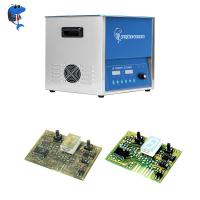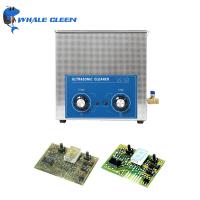38L 600Watt Ultrasonic Circuit Board Cleaner For PCB Board
Manufacturer
Why You Should Use Whale Cleen sonic Ultrasonic Circuit Board
Cleaner?
Everyone has gone straight from soldering to testing a circuit
board with good results, so is cleaning really need?
For precision work, absolutely. Even a small amount of solder
residue, solder flux, dust, dirt, and grim can cause a measureable
and significant change in behavior in a circuit, sometime it can
even prevent a circuit from working entirely. Scrubbing a circuit
board with a soft brush with alcohol can remove a lot of the
surface contaminates, but the residue left is still enough to have
an effect on circuit performance. The only way to really clean a
circuit board is to use an ultrasonic cleaner.
Specification:
| Specifications for ultrasonic cleaner z-x12 |
| Model | z-x12 |
| Tank capacity | 38L |
| Tank size | 500*300*250mm |
| Unit size | 640*440*470mm |
| Tank material | 2mm SUS304 |
| Ultrasonic power | 600W |
| Heating power | 1.5KW |
| Timer | 1-99h adjustable |
| Heater | 0-80c adjustable |
| Frequency | 28/40khz |
| Control | Inside generator, more stable |
| Optional | Oil filter system, pneumatic lift, rinsing tank, etc. |
| Voltage | 110V, 1phase; 220V, 3phases/220V, 1phase; 380V, 3phases |
| Warranty | 1 year |
| Packing | 1unit/wooden case
|
If this model is not suitable for your cleaning,please contact us
for more detail.
Cleaning Effect:

Things You Should Know Before Buying:
First specification point to consider is ultrasonic power. Without
getting into the nitty-gritty, more power usually indicates faster
and more effective cleaning, but more power is not always better.
For example, too much power can damage electronic parts and other
delicate items. For cleaning extremely sensitive items, equipment
with adjustable power allows the PCB manufacturer to experiment to
select the best power for a given PCB, or to accommodate a variety
of PCB configurations.
It is critical that the supplier has a cleaner that accommodates
the OEM’s PCBs. While this seems to be a “no brainer,” it is
essential when it comes to specifying cleaning tank dimensions and,
equally important, cleaning basket dimensions (which are slightly
less than tank dimensions). The baskets hold the PCBs in a vertical
position without crowding or board-to-board contact and must be of
sufficient size to allow total immersion in the cleaning solution.
This spec is called working depth and is the distance between the bottom of the basket and the
surface of the cleaning solution. If this information is not
available on the spec sheets, ask the manufacturer to supply it.
How To Clean With Whale Cleen sonic Ultrasonic Circuit Board
Cleaner?
Cleaning tanks have a fill line to indicate the maximum level of
cleaning solution. The supplier should fill the tank half way with
water, add the correct amount of cleaning solution concentrate for
a full tank, and then continue adding water to the fill line. The
unit is turned on to mix and degas the solution. Degassing fresh
cleaning solutions removes trapped air that interferes with
cavitation. Degassing time depends on solution volumes but
generally takes 10–15 minutes. Some units are equipped with a degas
mode that can speed the operation.
It is important to note that PCBs will cause solution displacement.
An experienced PCB supplier will know how to accommodate
displacement. The point to keep in mind is that an overfilled or
underfilled tank should be avoided. Once the solution is prepared,
it is ready to clean the PCBs. The operating parameters are set and
the unit is turned on. The PCBs are placed in the basket or rack
and lowered into the solution. The timer is set. At the end of the
cycle, the PCB is removed and inspected. If it is a go, the boards
are rinsed with deionized water to wash away cleaning solution
residues and allowed to dry.















